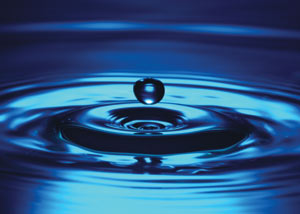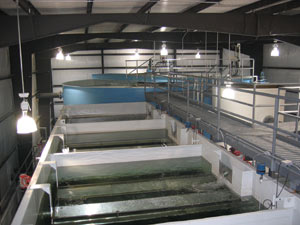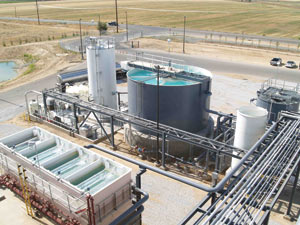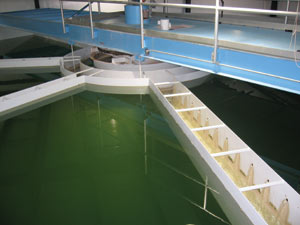Zero Liquid Discharge





January 19, 2010
BY Amelia Jordan
Regulations and environmental compliance parameters are being tightened, public perception of industrial manufacturing's impact on the environment is heightened and concerns are mounting over the quality and quantity of our water supply. As a result, zero liquid discharge (ZLD) systems have become more prevalent. ZLD is a term used to describe the complete elimination of liquid discharge from a manufacturing process. More companies and industries have to treat or eliminate waste streams to a much higher standard than ever before. There are several approaches to solving this problem, some of which can be integrated into existing processes. Thorough evaluation of the impact of feasibility, cost-both capital and operational-and complexity are very important before selecting a treatment strategy. This paper explores various traditional ZLD options, as well as some alternative approaches currently in use.
The goal of a well-designed ZLD system is to minimize the volume of liquid waste that requires treatment, while also producing a clean stream suitable for use elsewhere in the plant processes. Typical sources for waste streams in an industrial setting include cooling tower blow down, reverse osmosis (RO) concentrate, multimedia filter backwash and spent ion exchange (IEX) softener regenerant. The key to reducing overall wastewater flow is to select and/or optimize the equipment in order to optimize the flow stream quality generated by the equipment.
Cooling tower blow down volumes can be greatly minimized with the use of high-quality makeup water. This can be achieved by treating the makeup water for cycle-limiting ions such as hardness and silica. RO concentrate volumes can be minimized by integrating high efficiency systems to condition the water upstream of the RO units, such as softening, alkalinity removal and pH adjustments. A typical RO system rejects roughly 25 to 50 percent of the water it treats as waste; while a high efficiency system only has about 5 percent water waste. Filter backwash waste can be minimized by integrating backwash methods incorporating air wash scouring or simultaneous air and water techniques. The collected backwash water can be captured, settled and recycled, while the settled solids are collected in a filter press and disposed of. IEX backwash and regenerant waste can be recycled and reused.
A common ZLD approach is to concentrate (evaporate) the waste water and then dispose of it as a liquid brine, or further crystallize the brine to a solid. A typical evaporator uses tube-style heat exchangers. The evaporated water (distillate) is recovered and recycled while the brine is continually concentrated to a higher solids concentration.
Concentrated brine is disposed of in a variety of ways, such as sending it to a publicly owned treatment works, using evaporation ponds in areas with net positive evaporative climates (evaporation exceeds precipitation), or by treatment in a crystallizing system, such as a circulating-magma crystallizer or a spray dryer. Crystallized solids can be landfilled or applied to land, depending upon the crystal characteristics.
In April 2009, U.S. Water Services completed a complex water treatment system in Galva, Ill., combining high efficiency RO with evaporation/crystallization technology for the first time ever in an ethanol facility, in order to achieve ZLD. Due to environmental restrictions, applications such as these were necessary for the plant to operate. This particular facility integrated four major processes for the water to travel through. The first process is dual softening, consisting of a strong acid cation cycle and a weak acid cation. The second process is decarbonation, which greatly reduces carbon dioxide. A high efficiency RO unit was put in place as part of the third process, enabling water recoveries of 95 to 97 percent to be achieved, thus greatly reducing discharge volumes. The last process is evaporation and crystallization, where ZLD results can be achieved by evaporating down the waste stream volume by 80 to 90 percent. The remainder is then crystallized to a landfillable solid-in this case a salt cake-which is not hazardous to the environment.
Some industrial water consumers have installed cold lime softening (CLS) systems to precondition the water used for plant processes. CLS is a technology that has been around for decades. It is used to remove minerals, principally calcium, magnesium, iron and silica, from water fed to the cooling towers and RO systems, subsequently increasing efficiency and reducing waste volume.
In 2006, the first dry grind ethanol plant in the country to be designed and operated with no liquid discharge to the environment came on line in California. The process that allows for this environmentally friendly system was developed by U.S. Water Services.
Listed as an environmentally sensitive area, California's San Joaquin Valley does not allow any industrial aqueous discharge. In order to build the plant in this prime agricultural location, a process for reusing the discharge from the cooling tower, pretreatment equipment and process streams needed to be developed.
After carefully analyzing the local water quality, as well as the plant process demands, U.S. Water Services designed a process using CLS to precipitate many of the minerals from the water. The minerals, which are rich in calcium, are then added to the dried distillers grains with solubles, supplementing the nutrient value of this valuable animal feed byproduct of ethanol production.
As environmental, political and public health entities place more focus on waste water management, ZLD strategies are more often being evaluated for feasibility in industrial facilities. The ZLD approach taken, however, greatly depends on the quality of water available for use. Precipitation, evaporation, crystallization, recycling and other creative approaches, such as CLS, are all viable approaches to this end.
While most plants don't have the restriction of zero discharge from their facilities, CLS may still be a useful application. Depending on the specific permit regulations that a plant faces, it's often possible to significantly reduce liquid discharge volumes without actually eliminating it. In addition, many state permitting agencies see CLS as a means to pollutant control, as it is one of the few available processes that actually removes minerals from the water rather than simply discharging them in a concentrated waste stream as RO and IEX systems do.
The other important feature of CLS systems is that they allow the plant management much greater flexibility in the sources of water that can be utilized. For example, an ethanol plant in Minnesota needed to reduce the impact on the local aquifer, so it contracted with U.S. Water Services to design a CLS system that could treat river water. The plant has benefited in a number of ways from this project. Water usage for its cooling water and process systems dropped by more than 30 percent (roughly 45 MMgy) as a result of the improved water quality. More importantly, the water treatment system design allows it to utilize river water, well water and even water from a storm drainage pond, depending on which makes the most sense for the situation.
Through the use of new treatment technologies, and by using old technologies in novel ways, a significant impact can be made on the amount and quality of water that a process facility uses and discharges.
Amelia Jordan is a design engineer with U.S. Water Services. Reach her at (763) 553-0379 or ajordan@uswaterservices.com.
The goal of a well-designed ZLD system is to minimize the volume of liquid waste that requires treatment, while also producing a clean stream suitable for use elsewhere in the plant processes. Typical sources for waste streams in an industrial setting include cooling tower blow down, reverse osmosis (RO) concentrate, multimedia filter backwash and spent ion exchange (IEX) softener regenerant. The key to reducing overall wastewater flow is to select and/or optimize the equipment in order to optimize the flow stream quality generated by the equipment.
Cooling tower blow down volumes can be greatly minimized with the use of high-quality makeup water. This can be achieved by treating the makeup water for cycle-limiting ions such as hardness and silica. RO concentrate volumes can be minimized by integrating high efficiency systems to condition the water upstream of the RO units, such as softening, alkalinity removal and pH adjustments. A typical RO system rejects roughly 25 to 50 percent of the water it treats as waste; while a high efficiency system only has about 5 percent water waste. Filter backwash waste can be minimized by integrating backwash methods incorporating air wash scouring or simultaneous air and water techniques. The collected backwash water can be captured, settled and recycled, while the settled solids are collected in a filter press and disposed of. IEX backwash and regenerant waste can be recycled and reused.
A common ZLD approach is to concentrate (evaporate) the waste water and then dispose of it as a liquid brine, or further crystallize the brine to a solid. A typical evaporator uses tube-style heat exchangers. The evaporated water (distillate) is recovered and recycled while the brine is continually concentrated to a higher solids concentration.
Concentrated brine is disposed of in a variety of ways, such as sending it to a publicly owned treatment works, using evaporation ponds in areas with net positive evaporative climates (evaporation exceeds precipitation), or by treatment in a crystallizing system, such as a circulating-magma crystallizer or a spray dryer. Crystallized solids can be landfilled or applied to land, depending upon the crystal characteristics.
In April 2009, U.S. Water Services completed a complex water treatment system in Galva, Ill., combining high efficiency RO with evaporation/crystallization technology for the first time ever in an ethanol facility, in order to achieve ZLD. Due to environmental restrictions, applications such as these were necessary for the plant to operate. This particular facility integrated four major processes for the water to travel through. The first process is dual softening, consisting of a strong acid cation cycle and a weak acid cation. The second process is decarbonation, which greatly reduces carbon dioxide. A high efficiency RO unit was put in place as part of the third process, enabling water recoveries of 95 to 97 percent to be achieved, thus greatly reducing discharge volumes. The last process is evaporation and crystallization, where ZLD results can be achieved by evaporating down the waste stream volume by 80 to 90 percent. The remainder is then crystallized to a landfillable solid-in this case a salt cake-which is not hazardous to the environment.
Some industrial water consumers have installed cold lime softening (CLS) systems to precondition the water used for plant processes. CLS is a technology that has been around for decades. It is used to remove minerals, principally calcium, magnesium, iron and silica, from water fed to the cooling towers and RO systems, subsequently increasing efficiency and reducing waste volume.
In 2006, the first dry grind ethanol plant in the country to be designed and operated with no liquid discharge to the environment came on line in California. The process that allows for this environmentally friendly system was developed by U.S. Water Services.
Listed as an environmentally sensitive area, California's San Joaquin Valley does not allow any industrial aqueous discharge. In order to build the plant in this prime agricultural location, a process for reusing the discharge from the cooling tower, pretreatment equipment and process streams needed to be developed.
After carefully analyzing the local water quality, as well as the plant process demands, U.S. Water Services designed a process using CLS to precipitate many of the minerals from the water. The minerals, which are rich in calcium, are then added to the dried distillers grains with solubles, supplementing the nutrient value of this valuable animal feed byproduct of ethanol production.
As environmental, political and public health entities place more focus on waste water management, ZLD strategies are more often being evaluated for feasibility in industrial facilities. The ZLD approach taken, however, greatly depends on the quality of water available for use. Precipitation, evaporation, crystallization, recycling and other creative approaches, such as CLS, are all viable approaches to this end.
While most plants don't have the restriction of zero discharge from their facilities, CLS may still be a useful application. Depending on the specific permit regulations that a plant faces, it's often possible to significantly reduce liquid discharge volumes without actually eliminating it. In addition, many state permitting agencies see CLS as a means to pollutant control, as it is one of the few available processes that actually removes minerals from the water rather than simply discharging them in a concentrated waste stream as RO and IEX systems do.
The other important feature of CLS systems is that they allow the plant management much greater flexibility in the sources of water that can be utilized. For example, an ethanol plant in Minnesota needed to reduce the impact on the local aquifer, so it contracted with U.S. Water Services to design a CLS system that could treat river water. The plant has benefited in a number of ways from this project. Water usage for its cooling water and process systems dropped by more than 30 percent (roughly 45 MMgy) as a result of the improved water quality. More importantly, the water treatment system design allows it to utilize river water, well water and even water from a storm drainage pond, depending on which makes the most sense for the situation.
Through the use of new treatment technologies, and by using old technologies in novel ways, a significant impact can be made on the amount and quality of water that a process facility uses and discharges.
Amelia Jordan is a design engineer with U.S. Water Services. Reach her at (763) 553-0379 or ajordan@uswaterservices.com.
Advertisement
Advertisement
Advertisement
Advertisement
Upcoming Events





